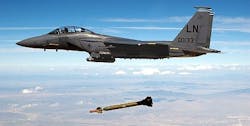Special Ops forces tap DRS to design and build SPOTR verification tool for laser designators
MAC DILL AFB, Fla., 6 Jan. 2012.Electro-optics engineers at the DRS Technologies Inc. Reconnaissance, Surveillance and Target Acquisition (RSTA) segment in Melbourne, Fla., will design and build a handheld laser sensor for U.S. Special Operations forces to verify that the 1064-nanometer infrared laser beam from the Handheld Laser Marker (HLM) is on target. The HLM is a lightweight system that marks targets for laser-guided munitions.
DRS RSTA engineers won a potential $40.2 million five-year contract Wednesday for the Spot on Target (SPOTR) system to verify the effectiveness of the Handheld Laser Marker in difficult conditions such as dark nights or urban terrain. Awarding the contract were officials of the U.S. Special Operations Command Procurement Division at MacDill Air Force Base, Fla.
DRS experts will build the SPOTR system to be no heavier than two pounds, which one operator can use together with the Handheld Laser Marker. DRS will design the SPOTR system to determine, detect, and verify than the HLM's 1064-nanometer infrared laser beam is working effectively in day, night, or day/night conditions.
Special Operations operators of the SPOTR system must be able to store it in a worn in a modular lightweight load-carrying equipment (MOLLE) pouch on load bearing equipment. The SPOTR shall not produce a visual signature or audible signature that will place a user at risk of detection.
DRS RSTA will do work on the contract in Dallas and in Melbourne, Fla., and should be finished by late 2016. For more information contact DRS RSTA online at www.drs.com/Products/RSTA, or U.S. Special Operations Command at www.socom.mil.
Related stories
Kollsman to design pocket-size laser target designator for Marine Corps warfighters
Tiny, rugged laser target designator for small UAV payloads introduced by Elop
Laser weapons development is pushing laser technology out of the laboratory and into directed-energy weapons applications in the field.
